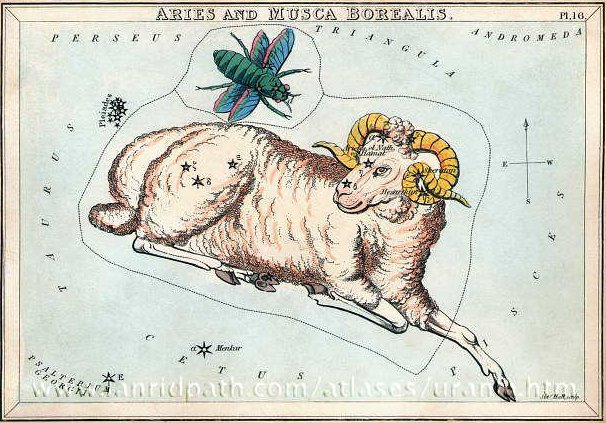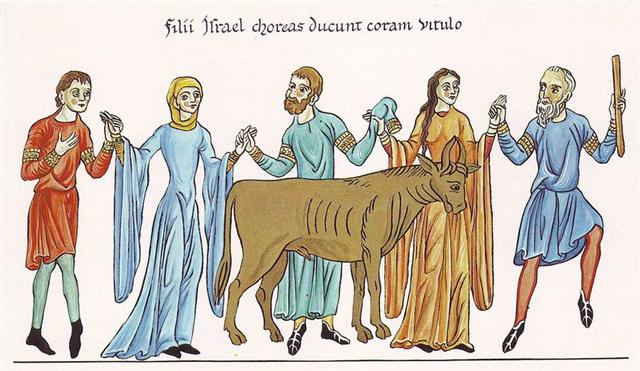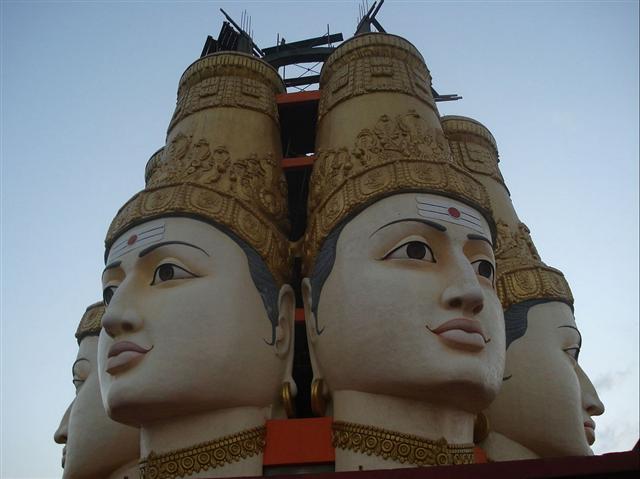161 → Φ. It had to be reexperienced, to be relearned, to be self-taught. Thus Hevelius and wife built a telescope by themselves:
Strings curved around fingers were not exact, but I suspect the creator of the text on the Santiago Staff sometimes might have given exact vector measures between pairs of stars, cfr I11-164. ... Freeman describres the dualistic cosmology of the Pythagorean school (-5th century), embodied in a table of ten pairs of opposites. On one side there was the limited, the odd, the one, the right, the male, the good, motion, light, square and straight. On the other side there was the unlimited, the even, the many, the left, the female, the bad, rest, darkness, oblong and curved ... The Golden Fleece was evidently from a very special kind of Ram, viz. Aries.  ... In Hellenistic astrology, the constellation of Aries is associated with the golden ram of Greek mythology that rescued Phrixos on orders from Mercury, taking him to the land of Colchis. Phrixos sacrificed the ram to the gods and hung its skin in a temple, where it was known as the Golden Fleece. The Golden Fleece was then stolen by Jason and the Argonauts.The First Point of Aries, the location of the vernal equinox, is named for the constellation. This is because the Sun crossed the celestial equator from south to north in Aries more than two millennia ago. Because of the precession of the equinoxes, the First Point of Aries has since moved into Pisces and will move into Aquarius by around 2600 C.E. The Sun now appears in Aries from late April through mid May ... We have found how Aries was probably pushed up
at ξ Arietis:  ... Aries only rose to its prominent position as the leading sign of the zodiac in the Neo-Babylonian (7th century BCE) revision of the Babylonian zodiac, as Hamal (α Ari) came to be located close to the point of vernal equinox. In Hellenistic astrology, the constellation of Aries is associated with the golden ram of Greek mythology that rescued Phrixos on orders from Mercury (→ 115), taking him to the land of Colchis ...
According to my assumed era for rongorongo (AD 1842) the star ξ Arietis should rise with the Sun in April 25 (115 = 80 + 35) → the planet named Mercury, Quicksilver. ... Mercury was used in the process of curing pelts for hats, making it impossible for hatters to avoid inhaling the mercury fumes given off during the hat making process; hatters and mill workers thus often suffered mercury poisoning, causing neurological damage, including confused speech and distorted vision ... If the Golden Calf was 'dethroned' ('shot down') by the Ram (with the Golden Fleece)
this could possibly have occurred around 35 (ξ Arietis) / 365.25 * 26000 (ancient measure for the cycle of the precessio) = 2491 = 1842 AD + BC 649. However, we should instead go from the 'birth' of the Julian calendar in BC 45 (→ 35 + 365 - 355). BC 45 + 2491 = BC 2536. This is the era when the great Egyptian pyramids were built.
So I guess the mythic era of the Argonauts could have been that same time. BC 2536 + 'around 2600 C.E.' = 5136. 513 * 6 → 3 * 171 * 6 → 6 * 9 * 19 * 3. Preliminary numercal results must always be tested again and again against the pair of relevancy (not 'truth') and beauty. Why did I dismiss counting from AD 1842? Because the Clashing Rocks 'froze to stone' when the Argonauts went through. ... The Argonauts, with the Golden Fleece on board, had to pass the Symplegades, the clashing rocks. Once a ship with its crew came through unharmed - so the 'blessed ones' (makaroi) had decided long ago - the Symplegades would stay fixed, and be clashing rocks no longer. After that 'accepting the novel laws of the fixed earth', they should 'offer an easy passage to all ships, once thay had learnt defeat'. This is only one station on the long 'opening travel' of the Argonauts transporting the Golden Fleece (of a ram), undertaken in all probability to introduce the Age of Aries, but it demonstrates best the relevant point, namely, 'the novel laws' ... In other words I think the Sun calendar (for the year) from that moment onwards no longer would be derived from the currently observed positions of the Full Moon (or from some other night side sign). It would no longer be 'lashed together with the hull of the other canoe'. Although the place for Easter Sunday - and Eastern (Island) was still tossed around from year to year. .... On the fifteenth day of the month of October (tangaroa uri), Nonoma left the house [he ea mai roto i te hare] during the night [i te po] to urinate outdoors [ki kaho.mimi]. At this point Ira called out [he rangi] to Nonoma, 'Look at the canoe!' Nonoma ran [he tahuti], he quickly went to Te Hiringa Heru (a ravine in the side of the crater Rano Kau) and looked around. There he saw the double canoe way out near the (offshore) islets [i te motu o haho], and the two (hulls of the canoe) were lashed together ... [E:75] ... The first of all foreign visitors on Easter Island was the Dutch admiral Jacob Roggeveen., who approached the island in the evening twilight of Easter Sunday, 1722. As the sun rose above the sea next morning the Dutchmen brought their ships close inshore and observed a mixed crowd of fair-skinned and dark-skinned people who had lit fires before some enormous statues standing in a row. The people ashore were squatting in front of the statues, with their heads bent while they alternatively raised and lowered their arms. When the sun rose they prostrated themselves on the ground facing the sunrise, their fires still flickering before the stone colossi. The statues were even then so old and eroded that Roggeveen could with his bare fingers break pieces away from the decomposed surface, wherefore he concluded that the giant figures were simply molded from clay and soil mixed with pebbles. The Dutchmen left the island after a single day's visit ... Presumably the Argonauts took over the place of the ancient shaman Stag (→ Red Deer → Robin Hood): ... A man had a daughter who possessed a wonderful bow and arrow, with which she was able to bring down everything she wanted. But she was lazy and was constantly sleeping. At this her father was angry and said: 'Do not be always sleeping, but take thy bow and shoot at the navel of the ocean, so that we may get fire.' The navel of the ocean was a vast whirlpool in which sticks for making fire by friction were drifting about. At that time men were still without fire. Now the maiden seized her bow, shot into the navel of the ocean, and the material for fire-rubbing sprang ashore. Then the old man was glad. He kindled a large fire, and as he wanted to keep it to himself, he built a house with a door which snapped up and down like jaws and killed everybody that wanted to get in. But the people knew that he was in possession of fire, and the stag determined to steal it for them. He took resinous wood, split it and stuck the splinters in his hair. Then he lashed two boats together, covered them with planks, danced and sang on them, and so he came to the old man's house. He sang: 'O, I go and will fetch the fire.' The old man's daughter heard him singing, and said to her father: 'O, let the stranger come into the house; he sings and dances so beautifully.' The stag landed and drew near the door, singing and dancing, and at the same time sprang to the door and made as if he wanted to enter the house. Then the door snapped to, without however touching him. But while it was again opening, he sprang quickly into the house. Here he seated himself at the fire, as if he wanted to dry himself, and continued singing. At the same time he let his head bend forward over the fire, so that he became quite sooty, and at last the splinters in his hair took fire. Then he sprang out, ran off and brought the fire to the people ...
And then we will realize that the planet Mars ought to have been involved. Because the Pleiades were considered as the place of birth for Kārttikeya.
|
|||||||||||||||||||||||||||









